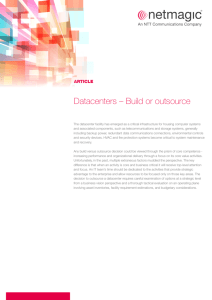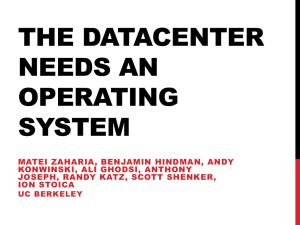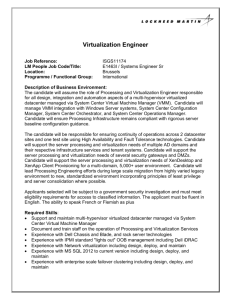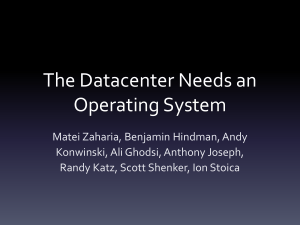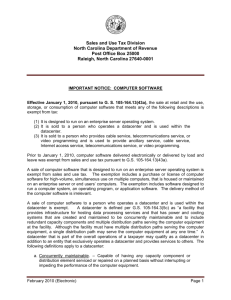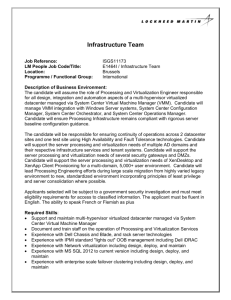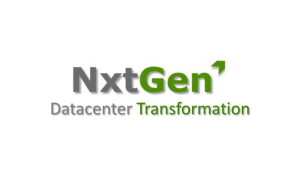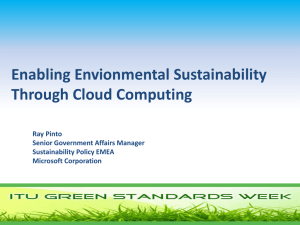I D C T E C H N... T h e N e x t ... Sponsored by Cisco Systems December 2009
advertisement
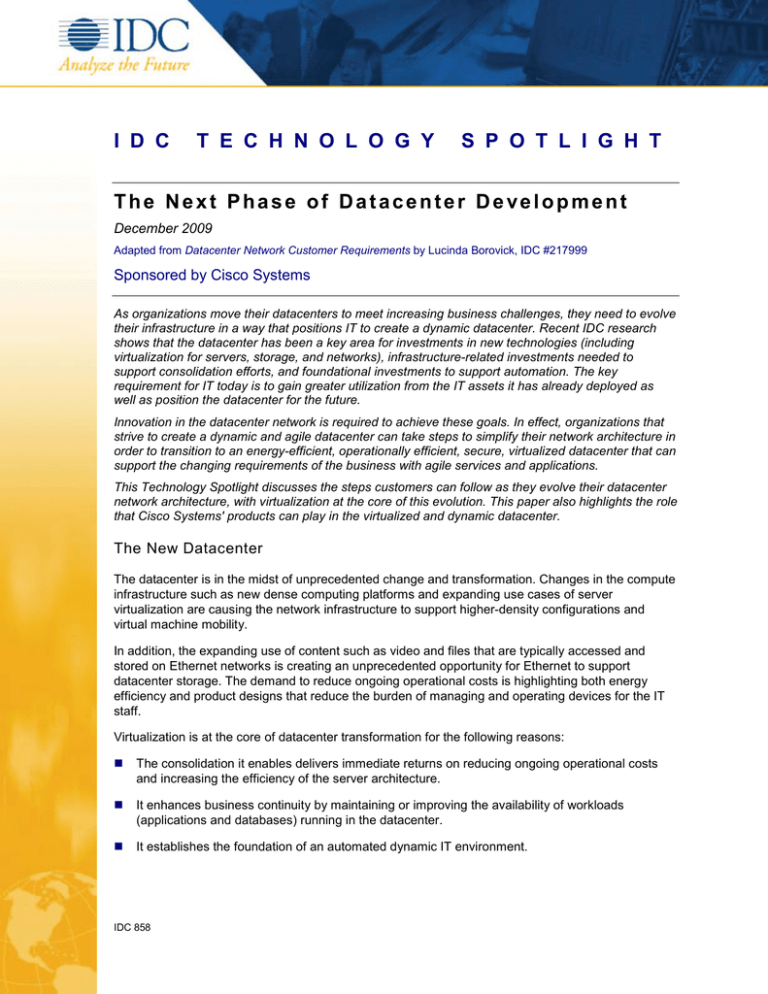
I D C T E C H N O L O G Y S P O T L I G H T The Next Phase of Datacenter Development December 2009 Adapted from Datacenter Network Customer Requirements by Lucinda Borovick, IDC #217999 Sponsored by Cisco Systems As organizations move their datacenters to meet increasing business challenges, they need to evolve their infrastructure in a way that positions IT to create a dynamic datacenter. Recent IDC research shows that the datacenter has been a key area for investments in new technologies (including virtualization for servers, storage, and networks), infrastructure-related investments needed to support consolidation efforts, and foundational investments to support automation. The key requirement for IT today is to gain greater utilization from the IT assets it has already deployed as well as position the datacenter for the future. Innovation in the datacenter network is required to achieve these goals. In effect, organizations that strive to create a dynamic and agile datacenter can take steps to simplify their network architecture in order to transition to an energy-efficient, operationally efficient, secure, virtualized datacenter that can support the changing requirements of the business with agile services and applications. This Technology Spotlight discusses the steps customers can follow as they evolve their datacenter network architecture, with virtualization at the core of this evolution. This paper also highlights the role that Cisco Systems' products can play in the virtualized and dynamic datacenter. The New Datacenter The datacenter is in the midst of unprecedented change and transformation. Changes in the compute infrastructure such as new dense computing platforms and expanding use cases of server virtualization are causing the network infrastructure to support higher-density configurations and virtual machine mobility. In addition, the expanding use of content such as video and files that are typically accessed and stored on Ethernet networks is creating an unprecedented opportunity for Ethernet to support datacenter storage. The demand to reduce ongoing operational costs is highlighting both energy efficiency and product designs that reduce the burden of managing and operating devices for the IT staff. Virtualization is at the core of datacenter transformation for the following reasons: !"The consolidation it enables delivers immediate returns on reducing ongoing operational costs and increasing the efficiency of the server architecture. !"It enhances business continuity by maintaining or improving the availability of workloads (applications and databases) running in the datacenter. !"It establishes the foundation of an automated dynamic IT environment. IDC 858 IDC believes the push to the next wave of virtualization in support of an on-demand datacenter will require a richer set of network services. Datacenter managers and IT decision makers want visibility into the logical infrastructure across datacenter domains. In this next generation, IT will be able to migrate mission-critical virtual machines across the datacenter and across the globe. Mission-critical workloads will not migrate to a virtual architecture unless they have the same consistent network security, management, and policies available on virtual ports as they do on physical ports. In the journey to a dynamic datacenter, organizations can simplify their infrastructure while taking a phased approach to building a dynamic datacenter. The Benefits of the Dynamic Datacenter Legacy datacenters face challenges around manageability, utilization, reliability, physical footprint, and energy efficiency. Ultimately, such challenges can combine to cause a degradation of service or higher costs, or both. As a result, IT organizations need to consider new technology approaches that change the traditional economics of the datacenter. To date, virtualization has been at the heart of this shift; however, IDC is increasingly seeing a requirement for purpose-built systems that lower the burden of integration for organizations across their server, storage, and networking resources. Such resources are required for the multiple workloads that IT shops typically run. IDC envisions customers taking an iterative approach to a dynamic datacenter depending on their server infrastructure and their current use cases for server virtualization. Among current use cases are the following: !"Virtualization for disaster recovery and hardware maintenance: disaster recovery; planned downtime !"Virtualization for capacity planning: pooling of resources; balance workloads based on hardware requirements and application requirements !"Virtualization for application availability: alternative to clustering; unplanned downtime; operating system application awareness !"Virtualization for policy-based automation: service-oriented computing; IT in the cloud !"Virtualization for consolidation: reduce the incidence of server sprawl The dynamic datacenter — which is characterized by flexibility and agility in order to respond to changing business requirements — needs a single low-latency network to realize the following capabilities: !"Manage workloads based on business priorities !"Provide virtual I/O, virtual network services !"Enable IT to leverage the cloud, which brings new workloads to the network The Step-by-Step Approach to the Dynamic Datacenter To enable the dynamic datacenter, organizations should ideally implement a phased approach that involves deploying virtualization technology initially to consolidate servers and gradually deploying virtualization throughout the datacenter infrastructure. Each phase of virtualization deployment should have operational goals and defined areas of ROI. The transition from a legacy datacenter to a dynamic datacenter is a challenging process that involves both technology and cultural transformation; having a well-defined road map as well as iterative and progressive milestones can help IT organizations successfully implement an infrastructure that will support the dynamic datacenter. 2 ©2009 IDC The four phases of datacenter transformation include the following: !"Server consolidation. This phase involves reducing TCO in the datacenter by consolidating multiple physical machines into virtual machines with higher utilization. There are significant cost benefits to consolidating physical machines with low utilization to multiple virtual machines running on fewer servers. !"Scalable dynamic datacenter fabric. This phase involves increasing the scalability, flexibility, and efficiency of the datacenter fabric by allowing any datacenter asset to access any other datacenter asset. This datacenter fabric will be based on 10 Gigabit Ethernet. The dynamic datacenter fabric will support sophisticated activities such as dynamic resource scheduling with virtual machines. !"I/O consolidation. This phase involves transitioning to a unified datacenter fabric to further reduce TCO by eliminating redundant components, including interfaces, cables, and switches. This I/O consolidation will support FCoE and iSCSI server access. !"Unified computing. This phase involves a fully virtualized datacenter with pools of computing, network, and storage resources. Enabling this datacenter are fully automated management and provisioning capabilities, resulting in improved cost efficiency and more responsive IT services. Virtualization — when applied throughout the datacenter (servers, storage, and networking infrastructure) — offers many of the same benefits as server virtualization: consolidation; cost savings; green IT; and dynamic, agile computing that responds to changing business requirements. In addition, such a unified computing environment offers the following benefits, which have both cost and operational advantages: !"Modular, repeatable design !"Ability to reuse locally, regionally, and worldwide !"Scalable capacity planning !"Ability to reduce overprovisioning !"Ability to facilitate the just-in-time datacenter !"Predictable operations !"Higher levels of availability Market Trends Large-scale datacenters have reached an inflection point where the combination of their physical infrastructure and the use of large-scale virtual servers is creating the need for new approaches to IT. This creates an opening for new architectures as well as new suppliers and solutions to enter the datacenter. The massive scale of the architecture arising in the datacenter is creating an opportunity for the datacenter network to evolve and have an important and unprecedented role to play in datacenter management. The attention being paid to the datacenter will intensify over the next few years and may in fact drive customers to consider alternative models or investments that they may not have considered recently. ©2009 IDC 3 Organizations will increasingly be looking for a compute and network resource that is purpose built for virtualization. Specifically, dynamic datacenters will require a very high memory footprint that can support a highly dense virtual environment as well as accelerate the adoption for applications with high I/O requirements, which have typically been outside the realm of virtualization. An architecture that provides virtual I/O and facilitates workload mobility — which is core to the dynamic datacenter of the future — is where organizations will increasingly make their datacenter investments. Datacenter managers are looking to build an architecture that is modular and offers a repeatable design that can be reused across the datacenter and multiple datacenters. Product Profile Cisco Systems is a San Jose, California–based provider of networking hardware and software products and is known for its core routing and switching technologies, as well as its advanced technologies such as application networking, unified communications, and virtualization. The products in the Cisco portfolio are designed to meet the needs of the next-generation virtualized dynamic datacenter. The following capabilities are consistent across the portfolio: !"High availability. Operational continuity that is integral to the design goals to meet the needs of an environment in which system availability is assumed and maintenance windows are rare, if not totally obsolete !"High performance. A highly dense, cost-effective, scalable infrastructure that enables increased efficiency in datacenter energy and budget resources !"Unified fabric. Transport that can navigate the transition to 10 Gigabit Ethernet and unified fabric and can handle architectural changes such as virtualization, Web 2.0 applications, and cloud computing The Cisco portfolio includes Cisco Nexus switches, which consist of the following: !"NX-OS. NX-OS is an operating system designed specifically for the datacenter and engineered for high availability, scalability, and flexibility. !"VN-Link. VN-Link provides virtual machine–aware network services. !"XML management. !"Network interface virtualization (NIV). NIV decouples I/O from compute. It enables I/O flexibility by creating greater numbers of I/O connections to a given server while limiting the number of required physical connections to the server. The Nexus products fit into Cisco's Datacenter 3.0 strategy, which is built around the company's Unified Computing System (UCS), an integrated solution of compute, network, storage access, and virtualization resources. Cisco's UCS is initially targeted at the growing virtualization market and is designed to address the major challenges that customers are currently facing in very large datacenter environments by easing the increasing complexities of the future datacenter. Challenges Cisco does face market challenges, however. The company needs to educate customers on the benefits of a unified network architecture in the datacenter. Additionally, because Cisco is the only provider on the market with a software switch that integrates directly with the server hypervisor to deliver VN-Link virtual machine–aware network services, Cisco needs to continue to educate customers about the TCO benefits of deploying its virtualization capabilities. 4 ©2009 IDC Conclusion As IT organizations continue the journey to the virtualization-enabled dynamic datacenter, the importance of the network increases. The advent of blades and server virtualization is causing the network infrastructure to support higher-density configurations. Virtualization technology is reshaping networking products and the delivery of network services. In effect, the datacenter of the future — one that is characterized by an ability to be agile and quickly and reliably support the changing needs of the business in an efficient, cost-effective manner — will be marked by virtualization-enabled mobility. In such an environment, virtualization will be deployed throughout the entire IT infrastructure, including servers, storage, and networks. IDC believes that a true unified fabric is on the horizon. The tidal wave of innovation that continues to accelerate around Ethernet will make this a reality. The capital savings around parts and the reduction in cabling, coupled with the operational savings from utility costs and associated cooling costs, are compelling. The need for more energy-efficient datacenter designs and equipment will make the unified fabric a reality and pave the way for automation in the datacenter. As organizations embark on designing datacenter strategies for the future, they will seek to implement network virtualization technologies that can enable agile and on-demand IT services. To the extent that Cisco can address the challenges outlined in this paper, IDC feels that the company has an opportunity to succeed in this market. A B O U T T H I S P U B L I C A T I O N This publication was produced by IDC Go-to-Market Services. The opinion, analysis, and research results presented herein are drawn from more detailed research and analysis independently conducted and published by IDC, unless specific vendor sponsorship is noted. IDC Go-to-Market Services makes IDC content available in a wide range of formats for distribution by various companies. A license to distribute IDC content does not imply endorsement of or opinion about the licensee. C O P Y R I G H T A N D R E S T R I C T I O N S Any IDC information or reference to IDC that is to be used in advertising, press releases, or promotional materials requires prior written approval from IDC. For permission requests, contact the GMS information line at 508-988-7610 or gms@idc.com. Translation and/or localization of this document requires an additional license from IDC. For more information on IDC, visit www.idc.com. For more information on IDC GMS, visit www.idc.com/gms. Global Headquarters: 5 Speen Street Framingham, MA 01701 USA P.508.872.8200 F.508.935.4015 www.idc.com ©2009 IDC 5
